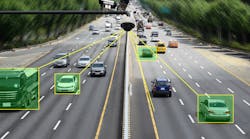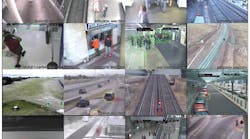Data-driven Physical Security Solutions Driving Proactive Risk Strategies
The professional security industry has traditionally been perceived to be a few steps behind the higher-profile consumer and broadcast business categories relative to its ability to organically innovate new technologies or adapt them from other industries. That apparent lag has changed over the past few years with the astonishing rate of new intelligent imaging, analytics and software management solutions coming to market that are laying the foundation for even greater advancements moving forward.
Many of these new products and system solutions are driven by users’ growing demand for big data and desire to leverage intelligent solutions that employ artificial intelligence (AI). What was once considered theoretical discussions on mining data from traditional physical security devices, like video surveillance cameras, new intelligent analytics, and the emerging Internet of Things (IoT) devices and sensors, have morphed into a new reality. This is changing how physical security systems are designed, implemented and managed, ushering in a new era of digital transformation and data-driven physical security solutions.
Data-Driven Physical Security Solutions
Perhaps the most significant takeaway from this new convergence of technologies is the genesis of data-driven physical security solutions that are proactive in nature, providing the ability to independently detect and analyze events and potential threats. This has the potential to dramatically increase the overall effectiveness and efficiency of physical security systems and operations by providing actionable insights that enable predictive analysis. In addition to improving overall security and safety, new intelligent physical security systems help to mitigate risk and provide new sources of business intelligence (BI) across the enterprise.
User demand for greater system intelligence is being driven by organizations seeking to make their operations more secure and efficient. However, the volumes of data generated by new intelligent systems require some degree of automation. This is especially true for organizations with large physical footprints, such as corporate and higher education campuses, municipalities, healthcare systems, airports and critical infrastructure. Embedding higher levels of intelligence in smart edge devices, like video surveillance cameras with embedded analytics that automatically detect anomalies and events of interest, provides a cost-effective high-performance solution for both new and existing physical security systems. Such new devices and solutions are also helping security personnel adhere to the continued cycle of new and evolving self-imposed and government-issued compliance regulations. This requires new and enhanced physical security systems to be flexible in order to best meet both long- and short-term security and safety objectives, justify investments in new systems and deliver a tangible return of investment.
New video surveillance cameras with embedded AI engines deliver a new level of intelligence to the edge. Not only do they produce better images that improve overall situational awareness, they provide expansive functionality and versatility that also help make system infrastructure and operations more efficient. Deep learning applications running directly on video surveillance cameras reduce the need for additional centralized analytics software and servers, resulting in lower total cost of ownership and faster data transmission and processing. These attributes facilitate a reduction in false alarms, improve security and first responders’ response times to real events of interest, and proactively identify potential threats as they are unfolding to help prevent them from escalating further.
Featured attributes of these new intelligent AI-embedded video surveillance cameras are far-reaching and include:
- Highly accurate detection and identification of individuals
- Target differentiation of people, animals and various types of vehicles
- Image optimization in low light levels and varying lighting conditions
- Optimized video compression to leverage available bandwidth and storage space
- Advanced video motion detection to identify intruders, loitering, cross line violations in protected/hazardous areas and the direct analysis of identified objects
- Personal privacy protection without compromised security is achieved by pixelating individuals’ figures or faces in live and/or recorded video
Perhaps the most significant attribute of this new generation of AI-embedded video cameras is their ability to accommodate customized analytics. Development partners can use software development kits that are available for these cameras to develop specialized analytics applications to meet their specific needs and challenges depending on the camera model and memory capacity. The ability to specify various combinations of embedded and customized analytics further adds to the high degree of specialization these devices provide for specific locations.
New Technologies Redefine Integrated Systems
In addition to AI-embedded video surveillance cameras, security system designers have a whole new arsenal of IoT devices available to increase the operational and organizational value of integrated surveillance and security systems. The list of devices already impacting new integrations includes body-worn cameras, in-car video systems, smart sensors, smartphones, robots and even drones for mainstream applications like intelligent perimeter protection, area occupancy monitoring, and pedestrian and vehicular traffic management. The addition of these networked edge devices is proving to enhance the detection and monitoring capabilities of physical security systems while making them more compliant, competent and visible across the enterprise. In essence, this helps both security and IT management reposition integrated physical security systems as a mission-critical business application on the enterprise level.
Combining new intelligent devices allows security and IT personnel to collectively put this enhanced data to work in a proactive manner. The fact that new and emerging sensory devices are migrating more intelligence to the edge inevitably increases situational awareness for many mainstream physical security applications. It also creates an expanded ecosystem for enhanced sensory detection and predictive analysis that helps organizations maintain a healthier bottom by capturing big data for a myriad of BI applications.
While the conventional integration of video surveillance and access control has proven to deliver significant benefits for physical security, we are just scratching the surface in terms of leveraging previously disparate system technologies. Add the ability to integrate building systems, like HVAC, lighting, logistics, elevators and life-safety/fire systems, and the range of intelligent applications further extends across the enterprise for facility management and BI applications. All of this is possible with leading open-architecture system-management software platforms. The number of applications for these new integrated systems is limited only by the imagination and ingenuity of today’s new generation of physical security system designers.
The professional security industry is at a new crossroads of technology. Convergence and systems integration that encompass new devices and technologies require higher levels of network expertise and promises to propel physical security into an expanded role within every organization’s framework. It’s a new vision and roadmap for our industry that will surely change the landscape of physical security systems and their role moving forward.








